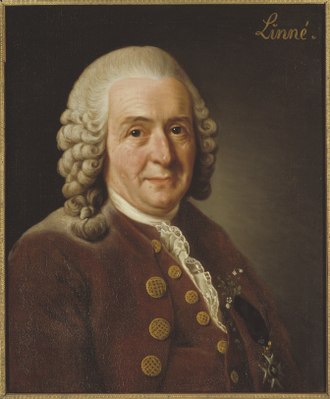Natural world as a reflection of the logic of God's creation
 Carl Linnaeus - the father of modern taxonomy
Carl Linnaeus - the father of modern taxonomy
Carl Linnaeus (1707 – 1778) was a Swedish botanist who formalised the modern system of naming organisms called binomial nomenclature. He is known by the epithet "father of modern taxonomy". Linnaeus developed his classification of the plant kingdom in an attempt to describe and understand the natural world as a reflection of the logic of God's creation. The Apostles of Linnaeus were a group of students who carried out botanical and zoological expeditions throughout the world that were either devised or approved by botanist Carl Linnaeus. The expeditions took place during the latter half of the 18th century and the students were designated 'apostles' by Linnaeus.
Many apostles began their journey from Sweden. Some would act as chaplains or doctors aboard a Swedish East India Company ship. The expeditions were often dangerous. Seven apostles never came home. The first apostle, Christopher Tärnström, died of a tropical fever on Côn Son Island in 1746. Tärnström's widow was angry with Linnaeus for making her children fatherless. After this incident, Linnaeus sent only unmarried men.
Many newly discovered plants, animals and insects were named and catalogued by Linnaeus and apostles. As a result,the apostles' expeditions helped spread the Linnaean taxonomy, a system for classifying organisms. Among Linnaeus' notable students, the most promising and committed ones made botanical expeditions to various places in the world. These seventeen adventurers were referred to as Linnaeus' apostles.
The tragic end of some of the apostles - their struggle for a good cause
Christopher Tärnström was the first apostle and he conducted botanical expedition in China. In early 1746, Tärnström received free passage on the Swedish East India Company ship Calmar to China. However, the ship stopped sailing beyond Côn Son Island because it had forced to find a winter berth. On 4 December 1746, Tärnström died of a tropical fever without a botanical or zoological specimen sent to Sweden. His widow blamed Linnaeus for making her children fatherless. Following the death of Tärnström, Linnaeus allowed only unmarried men to become his apostles Fredric Hasselquist sailed from Stockholm to Izmir (a city in Turkey) where he spent the winter. Subsequently, he sailed to Egypt where stayed for ten months before returning. He returned to Izmir with a rich collection of botanical and zoological findings and also minerals. On 9 February 1752, he died before returning to Sweden. During his expedition he accumulated a large debt and Linnaeus was informed that Hasselquist's collections and manuscripts would not be sent home until the debt was paid. Swedish Queen Louisa Ulrika paid the debt and Linnaeus received Hasselquist's findings. Olof Torén travelled to Surat and India as a priest with the Swedish East India Company in 1750. He continued to Guangzhou and China before returning to Sweden. He fell ill during his journey and died shortly after his return in 1753. He returned with a large collection of specimens. Pehr Löfling (1729–1756) travelled to Madrid in 1751 where he stayed for approximately two years. He explored the flora and fauna and regularly sent plants to Linnaeus. In 1754 he joined the expedition to South America. They first stopped in the Canary Islands, staying for a short time before continuing to Venezuela. In Venezuela, Löfling collected plants with the help of his two assistants. He died in South America at his 27th age. Daniel Rolander (1725–93) travelled to Suriname (on northeastern Atlantic coast of South America) in 1755. Although he became ill on the way, he had almost recovered by the time he arrived. In Suriname he tried to explore the rainforests but disliked the climate. He developed an alcohol addiction and his health began to decline. He stayed for seven months and then returned with a collection containing plants and insects. Carl Fredrik Adler (1720–61) sailed to the East Indies in 1761 on a Swedish East India Company ship. He also visited China and Java on the same expedition. His journey was short. He died later in the year of his departure while still in Java. Pehr Forsskål (1732–63) and the expedition sailed in the winter of 1761. Their first stop was Alexandria, Egypt. Forsskål made many findings at Suez and was one of the first to describe the flora and fauna of the Red Sea. The expedition reached Yemen in April 1763 where Forsskål found a Commiphora which Linnaeus was particularity interested in. However, Forsskål died of malaria on 11 July 1763 before he could deliver Commiphora to Linnaeus. Johan Peter Falk (1732–74) explored many places in Russia, including Volgograd and the steppes. During the journey Falk became addicted to opium and caused him to suffer depression throughout the expedition. In 1774 the expedition reached Kazan where Falk committed suicide. Andreas Berlin (1746–73) travelled to Guinea. The purpose of the expedition was to explore the central parts of Africa but prior to reaching the mainland, Berlin died of a stomach illness while on the Îles de Los. Before his death, Berlin managed to send a few plants to Linnaeus
|